Some thoughts about
frets
Fretwire size
has no real effect on intonation, but it has
everything to do with playability. Taller frets make
it easier to get clear notes: less finger pressure is
required, a fact that some people don't notice, but
which makes a life-and-death difference to others.
Some folks really like teeny frets, but more and more
makers, following the lead of the players who showcase
their instruments, are going for larger frets than
Gibson has ever used.
Taller frets also last longer as well because you
don't have to press so hard to get a clear note.
Again, some folks have to adjust their touch to take
advantage of this. But you don’t need to press your
finger to wood to get a clear note.
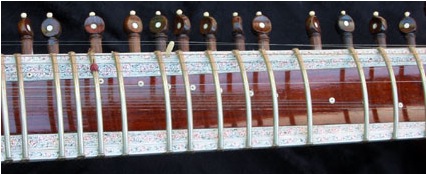 Mandolin Mandolin
I keep about 20 different wires for different
applications, but for mandolins I have used mostly the
old Dunlop 6280 or the Dunlop 6230 mentioned above.
I'm keeping my old 6280 for partials now, and am
moving to Jescar's 37080 and even their 43080, and for
a more minimal look, 37053 (in EVO). Stew-Mac's 147
and 148 wires are also hard to beat.
The typical vintage Gibson mandolin fret, at .034”
wide and .032” tall when new is, to me, absurdly
small. Most (though not all) of the serious pro
players in my mandolin clientčle prefer much heftier
ones, such as the Dunlop 6230 or the lamentably
extinct Dunlap 6280 (it was really close to 1930's
Gibson guitar frets). The old Dunlop 6280 was .076”
wide by .044” tall. I wish it was still available, I
like that size better. Both are about the same height,
but the 6230 is a tad wider and feels different.
Jescar makes a wire that seems to have all the answers
though, their 39040 (in either 18% NS or stainless),
it’s .039” tall by .040” wide. That’s practically
half-round. For folks who prefer really narrow wire,
as in the days of yore, I use Dunlop 6310.
Stew-Mac wires are made in Japan and are a bit harder
than the Dunlop wire. And some by Jescar, made in
Germany, are different than anything offered by the
other people. With the exception of stainless, which I
don't care for at all, the bigger and/or harder the
wire, the more trouble it is to install, but the
longer it will last. I believe it's worth the effort.
Guitar
My standard wires for my serious guitar clients are,
at the very least, Dunlop 6230 *, at .043” tall and .078”
wide or Jescar 's 43080 EVO wire which is nearly
identical. Going a little larger, Stew-Mac's #155, a
very fine 18%+ nickel wire which is .080" wide and
.050" tall. These are fairly narrow wires, not like
"jumbo" or electric bass frets anyway, but quite tall.
They seem to frame the industry standard for guitars.
A number of folks, particularly in the gypsy guitar
world, are turning to the Jescar 57110, .050” tall by
.110” wide, which comes in nickel, stainless or EVO
gold, which is hands-down the most durable wire on the
market, better than stainless, and infinitely easier
to work with. My experience with this wire over the
last few years has been a real revelation.
Banjo
There are so many different sizes of available
fretwire—not to mention what has been used
historically and how the various sizes and types are
used these days—that the term "banjo wire" means next
to nothing. It's like talking about "rosewood" -
another vague and extremely subjective term. I prefer
more precise descriptions instead: the crown height
and width, the alloy makeup, and to some extent the
work-hardness.
Some players want narrow, others want wider and
taller. I deal with a couple of these each week, week
in and week out, and I do what folks ask for. The
skinny frets seem to be favored by players who, for
one reason or another, are reluctant to break with the
old look.
Often, once they've really tried wider and taller
frets however, they see they're easier to get around
on and last longer, and then they make the jump.
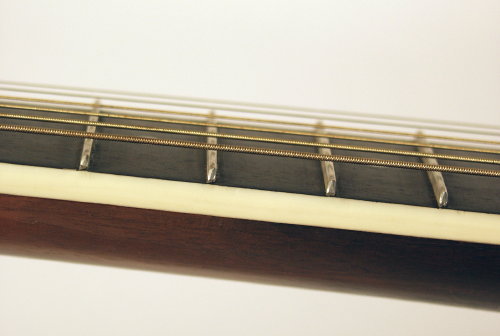
Speaking of which...
These are Lloyd Loar's "Fairy Frets" which were used
on his Viva-Tone guitars. It's the notion that 'a
higher fret is easier to play because getting clarity
requires less finger pressure' carried to an extreme!
I have only played on these a couple of times. I
suppose I could adjust to them, but doubt I'd really
want to try. I'd have loved to hear Lloyd Loar play
them though!
Digressions
Another factor in regarding fretwire is how people's
playing touch can change over time. Years ago I
refretted a mandolin for a guy who had bought his
mandolin new in 1955 or so. By 1985 he needed a refret
real bad. I did it with fairly similar wire (medium
height and width) and within six months he was getting
real anxious about how the new wire was so soft and
showing wear already. I explained that the wire I used
was 18% nickel, the hardest available. Dubious, he
said “It must be made of lead solder!” To prove his
point, he took one of his original frets and some of
the new stuff I'd used and had them assayed at a lab.
The original was 11% nickel and the stuff I used
actually came in at over 19%. What had changed was
that the guy
was older and his touch had changed. I've found that
older players generally squeeze harder. Squeezing
harder causes more/quicker fret wear. (I guess I'll
have to be more careful, now that I'm heading into
those final laps myself!)
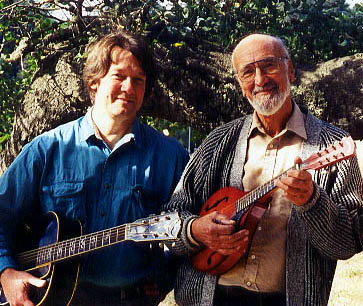
Another little anecdote. My main playing partner for
many years was a wonderful Sicilian mandolinist named
Tony Flores, who burned through two sets of frets a
year. Every year. He had two identical mandolins, and
he played hours and hours every day, and he managed to
wear divots in every fret from 1 to 11 under all four
courses that were so deep that milling was simply not
an option. These were standard old Dunlop 6280 frets:
hard, 18% nickel. Imagine a "partial refret" of the
first 11 frets every six months. It's a good thing he
knew me! Other players using these frets (myself
included) get way more use out of them because of how
they/we play.
Milling and dressing
You may need to mill and dress frets when they're
freshly installed to get rid of minor buzzes and so
forth, to make them feel smooth under your fingertips,
but milling is not a great idea to make cosmetic
divots go away.
Fret milling
as a routine maintenance procedure is so, um, Sixties.
When you do it, you lower all the frets to the lowest
point of the most worn fret, and in most instances,
that’s just a few frets. All you accomplish in milling
old frets is a look, at the expense of a lot
of fret life, and you increase playing difficulty, for
no good reason. I'd like to think the state of the art
has advanced some since then.
If one or two (or a typical situation where frets 1-5,
or maybe 1-7) are so worn they are causing audible or
physical playing problems, I replace only the bad
ones. In other words, if you notice that the frets are
wearing in spots only because you can see the
wear (but you can't feel or hear it), keep playing and
save your money for getting the frets attended to when
it really needs to be done. Replace them only when
they’re not working right anymore.
Sources:
Resellers:
This is not intended
to be an endorsement of anyone. There are other good
wires available, but these are the main ones I know of
and deal with in the US. These are not the entire
offerings of the suppliers noted above, merely what I
thought was important.
If you have comments, or corrections, please
drop
me a line.
Here's a simplified old Dunlop chart from the
days of yore. Their sizes have changed a bit, though I
have never found their specs to be
very reliable, even within a single roll.
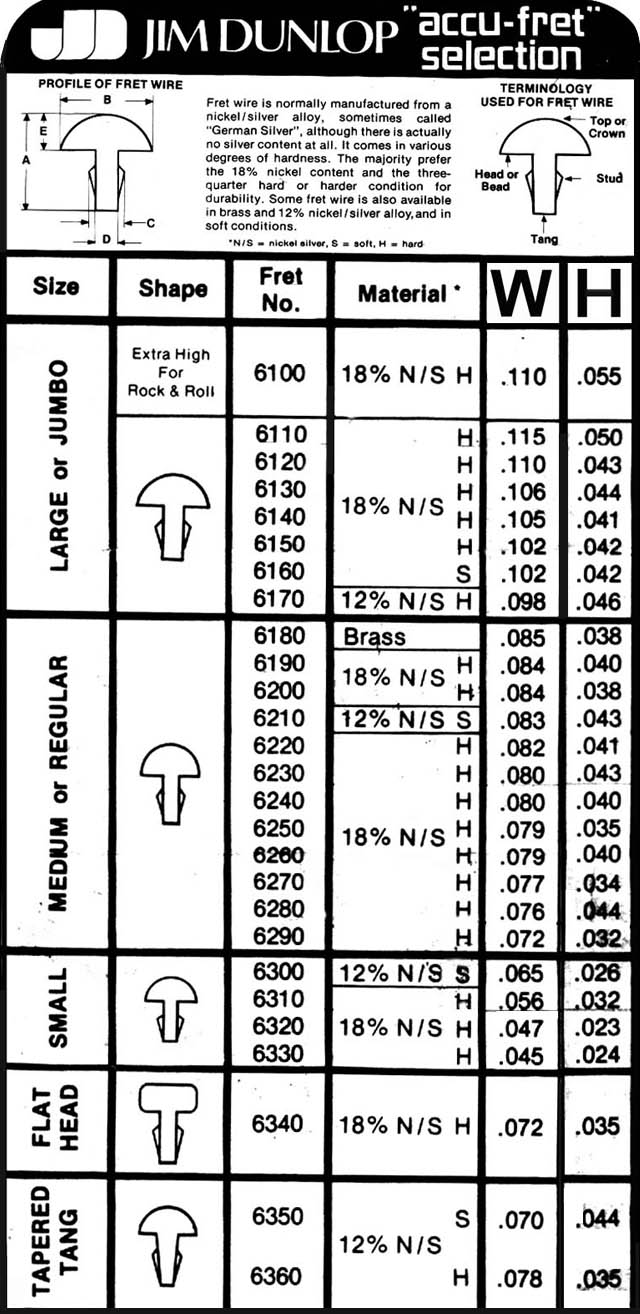
|
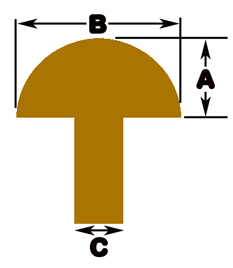

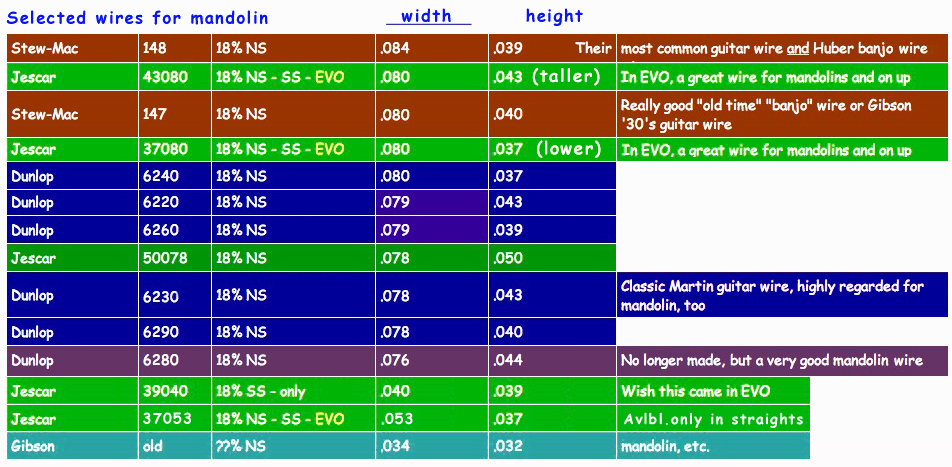
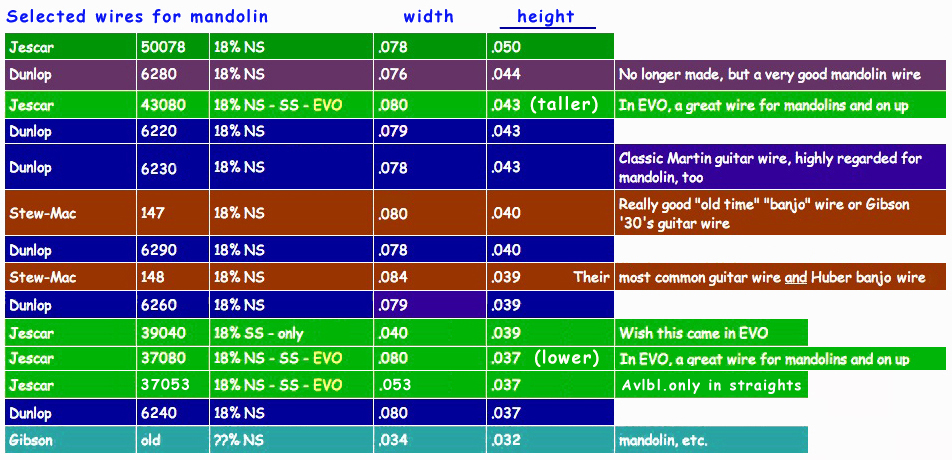
 Mandolin
Mandolin

